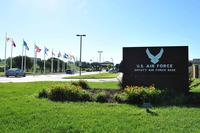An F-15E Strike Eagle on Tuesday shot down an armed drone belonging to the Syrian regime that was advancing on coalition forces in the southern part of the country, U.S. Central Command said.
The move comes days after an F/A-18E Super Hornet shot down an Su-22 Fitter fighter-bomber over Syria, which marked the U.S. military's first air-to-air kill involving manned aircraft in nearly two decades.
"The armed pro-regime Shaheed-129 [unmanned aerial vehicle] was shot down by a U.S. F-15E Strike Eagle at approximately 12:30 a.m. after it displayed hostile intent and advanced on Coalition forces," the command said in a release.
Officials said coalition forces were patrolling an established combat outpost to the northeast of At Tanf, where they're training and advising partner ground forces in the fight against ISIS.
Related content:
- Russia to Target US, Coalition Aircraft Over Syria
- US F/A-18E Shoots Down Syrian Su-22 in Air-to-Air Kill
- US F-15E Shoots Down 'Hostile' Predator-Like Drone in Syria
Similarly, an F-15E on June 8 shot down an unidentified drone deemed hostile toward coalition forces in At Tanf. During that incident, the drone dropped a single munition near U.S.-backed forces. It was also believed to be an Iranian-manufactured Shaheed drone.
Central Command on Tuesday said the drone shootdown happened in the same location. It marks the second time that forces supporting the Syrian government have attacked or tracked inside a so-called "deconfliction" zone near At Tanf, close to the Jordanian border.
"The F-15E intercepted the armed UAV after it was observed advancing on the Coalition position. When the armed UAV continued to advance on the Coalition position without diverting its course, it was shot down," the release said.
"The Coalition has made it clear to all parties publically [sic] and through the de-confliction line with Russian forces that the demonstrated hostile intent and actions of pro-regime forces toward Coalition and partner forces in Syria conducting legitimate counter-ISIS operations will not be tolerated," it said.
"We are very well prepared and positioned to defend ourselves," Operation Inherent Resolve spokesman Army Col. Ryan Dillon said earlier this month. "We've clearly showed we are able to do that. We do not want to continue this everyday [as it] distracts from our goal to defeat" the Islamic State, he said.
Contrary to reports from Russia's defense ministry, American officials on Tuesday said there is "a deconfliction mechanism in place" with Russian forces. The communications channel has been repeatedly used to avoid air mishaps and to relay messages of concern when hostile forces approach the deconfliction zones.
The deconfliction zone is an area in which U.S. and Russian forces have agreed not to operate. The zone previously applied to airspace but now includes ground territory, a defense official told Military.com.
The ministry on Monday said it suspended cooperation with the U.S. on deconfliction zones following the Su-22 shootdown. Russia has accused CentCom, the combatant command overseeing the Middle East, of violating the memorandum of understanding set up between the two countries in 2015.
The memorandum established a phone "hotline" the militaries use to alert one another of actions they're taking in Syria.
The strike against the pro-Syrian regime forces marks the fifth strike in recent weeks by the coalition.
U.S. Defense Secretary Jim Mattis has said the pro-Syrian forces are backed by Iran, and have been knowingly operating "inside an established and agreed-upon deconfliction zone."
They are believed to be a threat to coalition forces in the region, he has said.
Meanwhile, Russia said it will now track aircraft of any kind near its airspace in Syria with surface-to-air missiles given what it considers escalations by the coalition. Its defense ministry said it plans to track joint coalition aircraft west of the Euphrates River and treat them as targets, officials said Monday.
-- Oriana Pawlyk can be reached at oriana.pawlyk@military.com. Follow her on Twitter at @Oriana0214.




























